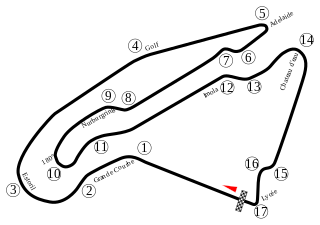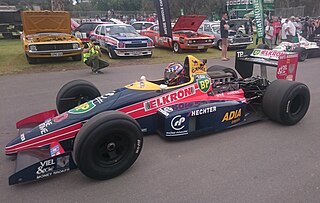Minardi was an Italian automobile racing team and constructor founded in Faenza in 1979 by Giancarlo Minardi. It competed in the Formula One World Championship from 1985 until 2005 with little success, nevertheless acquiring a loyal following of fans. In 2001, to save the team from folding, Minardi sold it to Australian businessman Paul Stoddart, who ran the team for five years before selling it on to Red Bull GmbH in 2005 who renamed it Scuderia Toro Rosso. Initially called "M" then a number, from 2001, all of Minardi chassis were called "PS", the PS being the initials of team owner, Paul Stoddart.
Arrows Grand Prix International was a British Formula One team active from 1978 to 2002. It was known as Footwork from 1991 to 1996.

The 1989 Italian Grand Prix was a Formula One motor race held at Monza on 10 September 1989. It was the twelfth race of the 1989 Formula One season.

The 1989 Spanish Grand Prix was a Formula One motor race held at Jerez on 1 October 1989. It was the fourteenth race of the 1989 Formula One World Championship. The 73-lap race was won from pole position by Ayrton Senna, driving a McLaren-Honda. Gerhard Berger was second in a Ferrari, while Senna's teammate and Drivers' Championship rival Alain Prost was third.

The 1991 French Grand Prix was a Formula One motor race held at Magny-Cours on 7 July 1991. It was the seventh race of the 1991 Formula One World Championship, and the first French Grand Prix to be held at Magny-Cours. The 72-lap race was won by Nigel Mansell, driving a Williams-Renault, with local driver Alain Prost second in a Ferrari and Ayrton Senna third in a McLaren-Honda.

The 1991 Australian Grand Prix was a Formula One motor race held on 3 November 1991 at the Adelaide Street Circuit. It was the 16th and final race of the 1991 Formula One World Championship. Torrential rain resulted in the race being stopped after just 16 of the scheduled 81 laps had been completed. The official results were declared from the end of the 14th lap, two laps before the race was suspended, in line with regulations. It held the record for being the shortest Formula One World Championship race until the 2021 Belgian Grand Prix. From a timing standpoint, it is the shortest Formula One World Championship race in history, as the race lasted barely 30 minutes from formation lap to abandonment.
The 1992 Canadian Grand Prix was a Formula One motor race held at Circuit Gilles Villeneuve, Montreal on 14 June 1992. It was the seventh race of the 1992 Formula One World Championship.

The 1993 Italian Grand Prix was a Formula One motor race held at Monza on 12 September 1993. It was the thirteenth race of the 1993 Formula One World Championship.

The 1994 FIA Formula One World Championship was the 48th season of FIA Formula One motor racing. It featured the 1994 Formula One World Championship for Drivers and the 1994 Formula One World Championship for Constructors, which were contested concurrently over a sixteen-race series that commenced on 27 March and ended on 13 November.

The 1993 FIA Formula One World Championship was the 47th season of FIA Formula One motor racing. It featured the 1993 Formula One World Championship for Drivers and the 1993 Formula One World Championship for Constructors, which were contested concurrently over a sixteen-race series that commenced on 14 March and ended on 7 November. Alain Prost won his fourth and final Drivers' Championship. As of 2024, this is the last championship for a French Formula One driver.

The Jordan 191 was a Formula One car designed by Gary Anderson for use by Jordan Grand Prix in its debut season in 1991. Its best finish was in Canada and Mexico, where Andrea de Cesaris drove it to fourth place at both races. Driving the 191 at the 1991 Hungarian Grand Prix, Bertrand Gachot took the fastest lap of the race.

The Lola LC88 is a Formula One car that the Larrousse team used to compete in the 1988 and one race in the 1989 Formula One season. It was an evolution of the previous LC87 model, and had major changes to the front suspension.
The Ligier JS37 was a Formula One car designed by Frank Dernie and Gérard Ducarouge for use by the Ligier team in the 1992 Formula One World Championship. The car was powered by the Renault RS3 V10 engine and ran on Goodyear tyres. It was driven by Belgian Thierry Boutsen and Frenchman Érik Comas, both in their second season with the team.

The Ligier JS35 was a Formula One car used by the Ligier team during the 1991 Formula One season. It was updated to a 'B' spec during the season. The car was powered by the Lamborghini V12 engine and ran on Goodyear tyres. Its best finish in a race was seventh (twice).

The Dallara F192 was a Formula One car designed by Giampaolo Dallara, of Dallara, and used by the BMS Scuderia Italia team during the 1992 Formula One season. The car was powered by the Ferrari V12 engine and ran on Goodyear tyres.

The Dallara F191 was a Formula One car designed by Giampaolo Dallara and Nigel Cowperthwaite for use by the BMS Scuderia Italia team during the 1991 Formula One season. The car was powered by the Judd V10 engine and ran on Pirelli tyres. Its best finish was at the San Marino Grand Prix when JJ Lehto drove it to third place.

The Minardi M191 was a Formula One car designed by Aldo Costa and Rene Hilhorst and built by Minardi for the 1991 Formula One season. The car was powered by the Ferrari V12 engine and ran on Goodyear tyres. Its best finish in a race was 4th (twice).

The BRM P201 is a Formula One racing car built by British Racing Motors and designed by Mike Pilbeam, which raced in the 1974 and 1975 seasons and in P201B specification in 1976 and 1977. The P201 featured a triangular monocoque, hip-level radiators, outboard front springs and inboard brakes. It used a 3.0-litre V12 engine and competed in 26 races, making 36 individual entries in total. Its best finish was second place for Jean-Pierre Beltoise at the 1974 South African Grand Prix, on the car's debut.

The HB is a series of 3.5-litre, naturally-aspirated V8 Formula One racing engines, designed, developed and produced by Cosworth, in partnership with Ford; and used between 1989 and 1994. The customer engines were used by Benetton, Fondmetal, McLaren, Lotus, Minardi, Footwork, Simtek, and Larrousse.

The Lamborghini LE3512 was a naturally-aspirated V12 motor racing engine, designed and developed by Lamborghini, to compete in Formula One. The engine was raced between 1989 and 1993.















